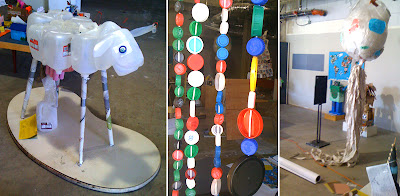As it does for many of us, the approach of January inspires me to review the past year for important ideas, and new insights to carry forward. In that spirit I have been going through notebooks lying on my desk and reviewing old notes to myself. This morning I came across a couple of pages about the North America Reggio Emilia Alliance (NAREA) conference from a year ago. The conference was held at my former high school (The Cambridge School of Weston) and hosted by my children's preschool (The Children's Garden).
One of the sessions was presented by an art educator from the Eric Carle Museum who talked about their art making/studio space. What she said has resonated with me for the past year and I recently returned to the notes I took to refresh my memory. Her perspective on the atelier is unexpected and lovely.
The art studio at the Eric Carle Museum is the same size as the gallery space which displays Carle's own work, and of the reading library. That in itself is unusual. There is equal priority given to display of the master artist, visitor making and creating, and focused investigation. In fact, it might be more accurate to say that looking at art, making art and reading about art are all seen as equally important means for delivering on the mission of the museum.
"To be a teacher, you need to be a learner and empower others to be learners with you."
This idea is at the heart of how the organization functions. Although the museum is about illustration as an art form, and about elevating Carle's work, the museum is open to new ideas from all directions. The focus is on meaning making and discovery. And programs are intentionally designed to appeal to a broad age range.
"The Studio is a laboratory for thinking" - Gandini and Topal wrote in Beautiful Stuff. And at the Carle Museum the art studio is seen as a space in which visitors are invited to talk about art and their response to it. But within the galleries as well there is an emphasis on encouraging visitors to talk to one another, communicate about the art, and debate. The docents use facilitated discussion to ensure that groups participate actively. The idea underlying this methodology is about doing something with the audience, not for them.
The goal is not only to make the looking at art active (VTS), but also to learn what people are thinking - what is in their minds so that the museum can learn from its audience. (There is a page on their website with links to documents discussing their philosophy in more detail).
The Studio
 The studio functions as a What If . . . space rather than a How To space. The space is designed to support visitor-to-visitor conversation. There is display of visitor-made work, and a mail box in which visitors write postcards for future visitors to read.
The studio functions as a What If . . . space rather than a How To space. The space is designed to support visitor-to-visitor conversation. There is display of visitor-made work, and a mail box in which visitors write postcards for future visitors to read. Large windows that look out on the garden provide a kind of living sculpture and backdrop to visitor work. One recent project invited visitors to make their own garden mural on the window, interacting with the natural environment as well as with the collaborative work-in-progress.
 Because the context is Eric Carle's work, and part of the concept is to find inspiration in his work, staff select a set of materials for visitors to work with, or set up a framework for them to add to. These starting points are chosen to offer multiple entry points and to encourage visitors to think in new ways.
Because the context is Eric Carle's work, and part of the concept is to find inspiration in his work, staff select a set of materials for visitors to work with, or set up a framework for them to add to. These starting points are chosen to offer multiple entry points and to encourage visitors to think in new ways. Within the studio the staff are also playing around with how to organize and present materials. They have been creating new categories such as thick and thin, or primary and secondary, rather than traditional ways of sorting art supplies.
This act of setting up the space is an act of preparation for visitors and it seems staff are still finding the right mix of openness and structure that works philosophically and logistically. For now, these starting points act as seeds which grow organically as visitors take them on and make them their own.
The Staff Role
The bigger picture is problem solving. When visitors are stuck staff ask them "what are you trying to do and how can we do that with what we have?" In fact, staff play a large role in the studio - asking questions, engaging adults and finding ways to include them. They treat communication as another experiment. They want displays to excite visitors and they want visitors to be curious. Recently they have been focusing on collaborating on displays with visitors - treating these also as starting points and inviting visitors to document their activity in the space as part of the communication for future visitors.
Space, Stuff, Staff
To inspire interpretation and reinterpretation. As the presenter in my NAREA panel said:
Pedgogy is movement. It is a journey of discovery. And it comes with responsibility to listen to others, solve problems and document the process.

























